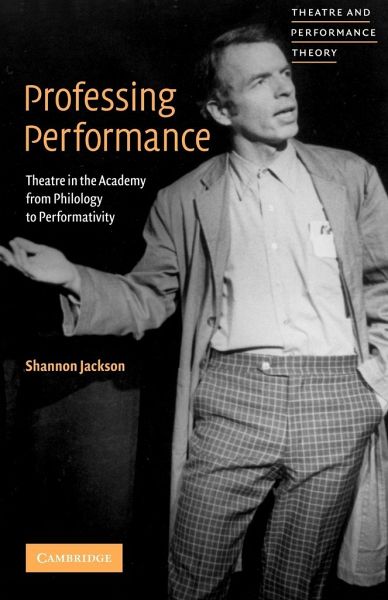
Professing Performance
Theatre in the Academy from Philology to Performativity
Herausgeber: Davis, Tracy C.
Versandkostenfrei!
Versandfertig in 1-2 Wochen
50,99 €
inkl. MwSt.
Weitere Ausgaben:

PAYBACK Punkte
25 °P sammeln!
Short description/annotationShows the relationship between past institutional histories and tradition and current scholarly and artistic practices in performance.Main descriptionToday's academic discourse is filled with the word 'perform'. Nestled amongst a variety of prefixes and suffixes (re-, post-, -ance, -ivity(?)33;), the term functions as a vehicle for a host of contemporary inquiries. For students, artists, and scholars of performance and theatre, this development is intriguing and complex. By examining the history of theatre studies and related institutions and by comparing the very d...
Short description/annotation
Shows the relationship between past institutional histories and tradition and current scholarly and artistic practices in performance.
Main description
Today's academic discourse is filled with the word 'perform'. Nestled amongst a variety of prefixes and suffixes (re-, post-, -ance, -ivity(?)33;), the term functions as a vehicle for a host of contemporary inquiries. For students, artists, and scholars of performance and theatre, this development is intriguing and complex. By examining the history of theatre studies and related institutions and by comparing the very different disciplinary interpretations and developments that led to this engagement, Professing Performance offers ways of placing performance theory and performance studies in context. Shannon Jackson considers the connection amongst a range of performance forms such as oratory, theatre, dance, and performance art and explores performance as both a humanistic and technical field of education. Throughout, she explores the institutional history of performance in the US academy in order to revise current debates around the role of the arts and humanities in higher education.
Table of contents:
1. Discipline and performance: genealogy and discontinuity; 2. Institutions and performance: professing performance in the early twentieth century; 3. Culture and Performance: structures of dramatic feeling; 4. Practice and performance: modernist paradoxes and literalist legacies; 5. History and performance: blurred genres and the particularizing of the past; 6. Identity and performance: racial performativity and anti-racist theatre.
Shows the relationship between past institutional histories and tradition and current scholarly and artistic practices in performance.
Main description
Today's academic discourse is filled with the word 'perform'. Nestled amongst a variety of prefixes and suffixes (re-, post-, -ance, -ivity(?)33;), the term functions as a vehicle for a host of contemporary inquiries. For students, artists, and scholars of performance and theatre, this development is intriguing and complex. By examining the history of theatre studies and related institutions and by comparing the very different disciplinary interpretations and developments that led to this engagement, Professing Performance offers ways of placing performance theory and performance studies in context. Shannon Jackson considers the connection amongst a range of performance forms such as oratory, theatre, dance, and performance art and explores performance as both a humanistic and technical field of education. Throughout, she explores the institutional history of performance in the US academy in order to revise current debates around the role of the arts and humanities in higher education.
Table of contents:
1. Discipline and performance: genealogy and discontinuity; 2. Institutions and performance: professing performance in the early twentieth century; 3. Culture and Performance: structures of dramatic feeling; 4. Practice and performance: modernist paradoxes and literalist legacies; 5. History and performance: blurred genres and the particularizing of the past; 6. Identity and performance: racial performativity and anti-racist theatre.




